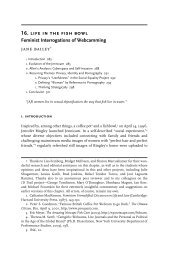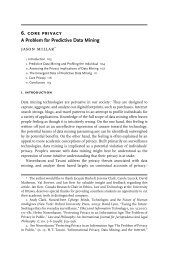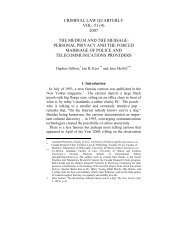Complete Cases Chart - Supreme Court of Canada - On the Identity ...
Complete Cases Chart - Supreme Court of Canada - On the Identity ...
Complete Cases Chart - Supreme Court of Canada - On the Identity ...
You also want an ePaper? Increase the reach of your titles
YUMPU automatically turns print PDFs into web optimized ePapers that Google loves.
Case Name (<strong>Court</strong>)<br />
(Judge)<br />
Location/Method <strong>of</strong> Search Relevant Statutes Issues/Holdings<br />
- (1) whe<strong>the</strong>r <strong>the</strong> search violates s. 8 <strong>of</strong> <strong>the</strong>C<strong>Chart</strong>er? - Y/N<br />
- (2) whe<strong>the</strong>r to exclude evidence by s. 24(2)? – Y/N<br />
Reasoning<br />
- (1) relevant to s.8 + CASES (Kokesch, Plant, Hunter, Tessling, Edwards)<br />
- (2) relevant to 24(2) + CASES (Collins)<br />
disrepute. Police were not engaged in unacceptable conduct – <strong>the</strong>y had satisfied<br />
<strong>the</strong>mselves that <strong>the</strong>y were engaged in a lawful seizure incidental to an arrest.<br />
- Ref. to Collins and Dyment<br />
NS COURT OF APPEAL<br />
R. v. LeClaire<br />
2005 NSCA 165<br />
Roscoe J.A.;<br />
Cromwell and<br />
Freeman JJ.A. (con).<br />
* final level<br />
Property - Home<br />
(perimeter search)<br />
- Police see a door leading<br />
from <strong>the</strong> accused’s garage to<br />
his living area.<br />
-They enter <strong>the</strong> open garage<br />
and see a man through <strong>the</strong><br />
door window.<br />
- Police knock on <strong>the</strong> door,<br />
advise <strong>the</strong> accused that <strong>the</strong>y<br />
are investigating an impaired<br />
driving complaint and ask if<br />
<strong>the</strong>y may enter house.<br />
- They are invited in.<br />
- <strong>Chart</strong>er, s.8. - (1) Did entering through <strong>the</strong> garage door<br />
violate s.8?<br />
• NO<br />
- There is an implied license for members <strong>of</strong> <strong>the</strong> public and police to approach <strong>the</strong><br />
door <strong>of</strong> a residence and knock.<br />
- In <strong>the</strong> case <strong>of</strong> <strong>the</strong> police, <strong>the</strong> purpose <strong>of</strong> <strong>the</strong> approach will be determinative as to<br />
whe<strong>the</strong>r conduct falls within <strong>the</strong> ‘implied invitation to knock.’ If police simply<br />
wish to communicate or are conducting an investigation <strong>the</strong>n <strong>the</strong>y’re within <strong>the</strong><br />
implied license. If, however, police approach to ga<strong>the</strong>r evidence or determine<br />
whe<strong>the</strong>r suspected evidence becomes apparent when <strong>the</strong> door is opened <strong>the</strong>n <strong>the</strong>y’re<br />
not within <strong>the</strong> implied invitation to knock. (SCC Evans)<br />
- The distinction is based on <strong>the</strong> fact that one can refuse to answer questions -<br />
nothing is unwittingly disclosed.<br />
- Evans has been applied in several similar cases concerning entering onto <strong>the</strong><br />
property in connection with drunk driving suspicions.<br />
- A direct route to <strong>the</strong> door is required. Police may not take a trespassory detour to<br />
use <strong>the</strong>ir senses (sight/smell) to ga<strong>the</strong>r evidence.<br />
- When police first entered <strong>the</strong> home <strong>the</strong>y engaged <strong>the</strong> accused in ‘open-ended’<br />
conversation. They had no grounds for arrest until <strong>the</strong>y observed <strong>the</strong> condition <strong>of</strong> <strong>the</strong><br />
accused and he acknowledged that he had been driving.<br />
- The implied invitation to knock applies only to places where one can conveniently<br />
knock.<br />
- Ref. to Evans<br />
R. v. Wood<br />
2001 NSCA 38<br />
Roscoe J.A.;<br />
Hallett and Cromwell<br />
JJ.A. (con).<br />
* final level<br />
<strong>Identity</strong> – Records<br />
- A barrister provided<br />
financial records to <strong>the</strong> Law<br />
Society as part <strong>of</strong> a regulatory<br />
process.<br />
-The records were<br />
subsequently seized under a<br />
warrant and used against <strong>the</strong><br />
barrister at trial.<br />
- <strong>Chart</strong>er, ss. 7 and 8. - (1) Was <strong>the</strong> accused’s reasonable<br />
expectation <strong>of</strong> privacy (per ss. 7 and 8)<br />
violated?<br />
• NO<br />
(2) Should <strong>the</strong> evidence be excluded?<br />
• NO<br />
- (1) The accused was required, as a condition <strong>of</strong> practising law, to provide<br />
documents to <strong>the</strong> Law Society upon request. These records were accessed under a<br />
lawful warrant. There is little, if any, reasonable expectation <strong>of</strong> privacy in business<br />
records required to be maintained as a condition <strong>of</strong> practising law.<br />
- (2) The <strong>Court</strong> also found that if <strong>the</strong>re were a breach <strong>of</strong> s.8 <strong>the</strong> records would not be<br />
excluded under s.24(2).<br />
- Ref. to Hunter (purpose <strong>of</strong> s. 8).<br />
53







